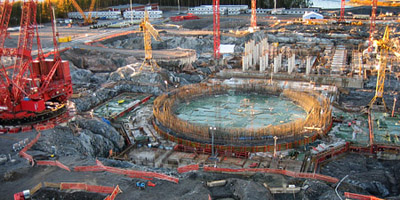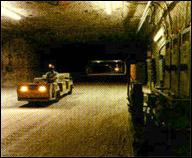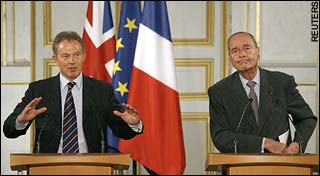
The disputed low carbon property of nuclear power has been used as a fix for its economics, in that the additional generating costs can be discounted by subtracting carbon trading credits. Thus, the return on the initial capital, over an operating cycle claimed to endure for 35 to 60 years, depends on a fiscal device, which might not survive a change of administration.
Carbon emissions
As a measure to combat the rising perception of climate change caused by emissions of carbon dioxide, nuclear power appears on first sight to offer a low carbon solution and a secure supply to replace an ageing UK nuclear sector, which contributes around 20% of electricity generation. It provides around 8% of the UK's thermal energy, but only 3% of its useful energy as electricity.
It is claimed that nuclear power is a source of low carbon energy, but even if this were true and even if the number of stations were to be doubled rather than simply replaced, the reduction in emissions would be overwhelmed by those resulting from additional gas and coal fired stations needed to supply the increasing demand for electricity.
Energy review requirements
In the UK over the past two years a number of initiatives have set the political scene for the building of new nuclear stations to replace the existing fleet, all of which will be decommissioned by 2023, except for the last one to be built, Sizewell B on the Suffolk coast, in 2035, culminating in the publishing on 10 July 2006 of the UK Trade and Industry department's Energy Review .
Paragraph 5.96 of it reads:-
"Any new nuclear stations would be proposed, developed, constructed and operated by the private sector, who would also meet full decommissioning costs and their full share of long-term waste management costs."
The disputed low carbon property of nuclear power has been used as a fix for its economics, in that the additional generating costs can be discounted by subtracting carbon trading credits. Thus, the return on the initial capital, over an operating cycle claimed to endure for 35 to 60 years, depends on a fiscal device, which might not survive a change of administration.
On privatisation, British Energy (BE) shareholders acquired a written-down set of
- one major coal-fired station at Eggborough and eight nuclear stations.
- They also inherited a £5 billion nuclear liability, requiring the payment of an annual levy to contribute to a clear-up fund.
As part of a rescue package, the British government took over the BE decommissioning and radioactive waste handling problem, which will eventually be costed and added to the current £70 billion bill estimated by the newly created Nuclear Decommissioning Authority.

The Committee for Radioactive Waste Management (CoRWM) has published its recommendations for the long-term management of radioactive waste. They include interim management and storage of waste prior to the final geological disposal underground. The time scale of its programme extends to 2120 with the excavation of the repository taking place from 2035 to 2045. The costs of such complex, multiple activities over more than a century can only be guessed, but could amount to an additional £30-£50 billion, including £10-£15 billion for the underground storage. CoRWM has declined to assess the additional requirements arising from a programme of new reactor build, assuming that this would extend the waste inventory, have an effect on the design and size of the repository and the overall timeline.
In the past the generators have contributed to a nuclear liability fund from a levy on the revenue, but, if as could well have happened to BE without state intervention, the owner went into voluntary liquidation, or for various reasons the operational life is curtailed, for safety reasons or lack of fuel, once again the state would have to pick up the tab.
So the only way to ensure that the nuclear liability fund is adequately remunerated is for the generator to put up a bond of a sufficient size to be able, during and at the end of the operational life of the reactor, to cover the costs of spent fuel handling, decommissioning and final disposal. It could be seen as a sort of "pension fund" for "retired" reactors. The problem occurs after nuclear fission is over and by mid-century the availability of fossil fuels to perform the waste decommissioning and waste disposal is uncertain. So the cost of the fuels needed to perform the end functions may well be astronomical and should be factored into the lump sum comprising the bond.
Private sector?
In the lead up to the issuing of the Energy Review, the British state-owned station builder Westinghouse has been sold to Toshiba, leaving the field open to the French Areva, which is currently building the Evolutionary Pressure Reactor in Finland (EPR).

Six EPR's with a capacity of 1.6 GW (gigawatts) would be easier to place on existing sites than ten Westinghouse AP1000's with a lower capacity of 1 GW. The winner of the first contract would inevitably gain the rest of the fleet as the licensing of a reactor is a time-consuming and expensive affair.
The French generator Electricité de France (EdF) has already
acquired part of the UK distribution sector and has stated that it is
ready to build nuclear power stations in Britain without subsidy, but
has hinted that it would need assured carbon credits instead. 

As EdF and Areva are around 85%-owned by the French state, they would need no subsidies, but to avoid decommissioning and waste handling costs, they could simply put the UK companies into liquidation once generation ceases. The French government should therefore indemnify the British government in lieu of a bond.
Supply chain
Areva is a nuclear complex involved in station building and nuclear fuel manufacture and reprocessing, supplying 58 nuclear stations in France, 39 stations in other countries and eventually the EPR in Finland. For this it requires the importation of around 15,000 tonnes per year of raw uranium, its own indigenous mines having been worked out. Through its Cogema holdings in Canada, Niger and Kazakhstan it has access to only 6,000 tonnes, relying on supplies among others from Australia which are now committed to China.

An advantage that Tony Blair grasped was that 90% of the nuclear waste remains in France, as the actual nuclear fuel comprises only the enriched fraction. This enabled the Finns to excavate an underground storage for the spent fuel of a moderate size as the bulk, mostly depleted uranium will remain in France, some of which may be reprocessed.
Around 40% of a global 65,000 tonnes annual uranium demand comes from ex-weapons grade highly enriched uranium, from re-worked mine tailings and from inventories. Delegates at three recent symposiums of the World Nuclear Association (WNA) reported that these so-called secondary sources will be gone by 2012 and their presence in the market has up until now kept uranium prices low, suppressing investment in new mines.

Source: TradeTech (Denver, Colorado)
The current world interest in nuclear power has stimulated a frenzy of prospecting, but little positive action to open new mines able in their aggregate to supply the missing 30,000 tonnes and to replace output from mines due to close, such as the Ranger mine in Australia in 2008. Russia is in deficit for its internal uranium needs and supplies those in its hegemony from its dwindling inventories. It has concluded a deal in Kazakhstan to build a nuclear power station and open a mine, effectively excluding the French. Uzbekistan may follow a similar pattern. If the expansion of the Olympic Dam underground mine in South Australia as an open pit passes its feasibility study, the first uranium will come out of the ground in 2014 and will supply the new Chinese fleet of 30 reactors. China has offered to dig its own mines in Australia and is seeking equity in Australian mining companies.
The nuclear industry has scorned complaints that point to the coming shortage of uranium, arguing that rising prices will allow low grade ores to be added to the reserves. However, in a world facing rising oil costs and shortages, the recourse to open pit mining employing huge diesel powered machinery to shift ever increasing amounts of rock for decreasing ore grades and lowering extraction yields, will compound the rising costs of the mining.
EdF owns the French electricity supply industry, which relies on the nuclear sector for 78% of its electricity. Maintenance of its nuclear generation will rely on sufficient supplies of raw uranium reaching its fuel supplier, Areva, which has also built reactors in Belgium, South Africa, South Korea and China. If EdF builds reactors in Britain, the UK will be added to the list of countries reliant on Areva's fuel manufacturing.
So "keeping the French lights on" may take priority over the external dependents.
Considerations
- Can EdF and Areva be described as members of the "private sector"? Will such a return to nationalised industry in the UK, albeit the French state sector, be in conflict with EC competition policy?
- Can EdF provide a reassurance that it will "meet full decommissioning costs" and its "full share of long-term waste management costs" ?
- Can Areva procure sufficient raw uranium to maintain generation in France, the other dependent countries and in the UK over the operational life of the nuclear stations it has built and will build?
Entente cordiale?
Prior to the release of the Energy Review on 9 June, 2006 Tony Blair and Jacques Chirac met in Paris to make their plans for the Napoleonic invasion of Britain, which will place a row of nukes on the coasts of Britain between the Martello towers readied for a previous invasion that failed to materialise.

[See the Busby Report http://www.after-oil.co.uk ]
© Sanders Research Associates 7 August 2006